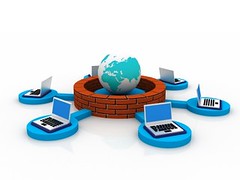Trying to define the scope of the information security organisation and ensure that the appropriate elements are included is still given much consideration. My view on this is to go back to basics and look at what you are trying to achieve with this function. Information Security is concerned with the Security of Information (shocker!) and in order to achieve this you need to consider what information is; in what forms it is stored, processed and transmitted; and by whom, which mechanism or within what type of environment/container. These factors allow you to assess the vulnerabilities of information in the various formats and situations, what threats are present and therefore what the risk is to that information... this is probably sounding familiar.
When considering the risks around information in IT systems, this includes any piece of IT in your environment from the enterprise level systems management environment to the USB stick on a keyring. These systems will hold information or be capable of holding information which should be classified by the organisation according to its sensitivity. Even devices which don't have an end-user storage capability such as network devices hold device configurations, the disclosure of which to unauthorised parties might compromise the desired obscurity of the network configuration or the intellectual property of the organisation who defined the configuration in the first place.
The "wider than just IT" remit
A key considerations needs to be information in other, non-IT forms: Contracts, financial documentation and HR records on paper are key information assets to the organisation and should be included in any risk assessment. People are the other element for consideration. Who is going to access your information: Employees? contractors? customers? third-parties? Once information has been read then it is transferred to a much more unpredictable storage medium, the human brain. Information that was once in a secure environment within the corporate building becomes "you'll never guess what I've just read about!" on a mobile phone on a train. The reputation of your organisation is therefore an asset at risk. Once in the hands of people, your control over your information is reduced and other controls both IT and non-IT are required to protect the data, from encryption on portable media to awareness training.
In considering the threats and vulnerabilities of information, you need to consider how you manage the information in a number of circumstances, how you control the information assets in your company and how you ensure that your employees, contractors, customers and third-parties are trustworthy enough to have the information, are trained in the importance of information protection and have contractual or legal measures to protect the company from any unauthorised disclosure. You also need to consider the physical environment in which the information is held. It's all very well putting amazing IT controls in place if someone can walk into an office or datacentre and simply stroll away with it.
The ability to respond to adverse events will also act as a key control to reduce risk. The more prepared you are, the faster you can react to any event which threatens the security of information, the more you can limit any damage and the faster you can recover. Incident Management and Business Continuity therefore go hand in hand to address this requirement at different levels. Preparation includes training, good information flows, documented processes, awareness and exercises. Key to this is ensuring that everyone has the ability to identify a security incident and alert the appropriate contact - defining when an incident becomes a security incident is another topic for discussion.
Once all these factors are included with all the IT controls, they must be checked for compliance, which includes not only to internal policies but also to legal and regulatory standards. Many standards with which organisations need to comply will go beyond the IT systems and focus on the information itself, such as data protection legislation.
How the scope pans out
The scope of information security therefore includes elements such as IT Operations, Human Resources, procurement, service management, physical security, incident management, business continuity, legal and compliance. There will be separate departments that implement and manage the controls within the organisation and it is the remit of information security to ensure that the processes they operate take into account the controls required to mitigate the risk and that cooperation is obtained for audit and compliance work. This should be in the form of a working partnership, not a dictatorship.
When you consider particularly the integrity and availbility of information in addition to confidentiality, the scope increases further. As an example, physical security should include not just fences, locks, biometrics and CCTV, but also the physical attributes to maintain the availbility of data such as the ability of the building to resist environmental threats such as extreme weather, the stability of ultilities such as electricity and the resilience of the cooling system in server rooms.
Security can be whatever you make it, and different models will fit different organisations. However, to properly consider all the risks to the information you need to protect, you need to think beyond the IT and look at all the information that is of value to your organisation in any format.
Image: jscreationzs / FreeDigitalPhotos.net

No comments:
Post a Comment